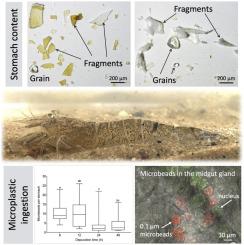Our official English website, www.x-mol.net, welcomes your
feedback! (Note: you will need to create a separate account there.)
Coping with the “dirt”: brown shrimp and the microplastic threat
Zoology ( IF 1.6 ) Pub Date : 2020-12-01 , DOI: 10.1016/j.zool.2020.125848 Špela Korez , Lars Gutow , Reinhard Saborowski
Zoology ( IF 1.6 ) Pub Date : 2020-12-01 , DOI: 10.1016/j.zool.2020.125848 Špela Korez , Lars Gutow , Reinhard Saborowski

|
Microplastic pollution is an emerging threat to marine biota. Uptake of microplastics can impair nutrition and affect the performance of organisms. However, the vulnerability to microplastics seems to vary between species for yet widely unexplored reasons. We investigated the stomach content of the brown shrimp, Crangon crangon, from the southern North Sea and performed feeding experiments and anatomical studies of the digestive organs to comprehend the distribution of fluorescent microparticles within the shrimp. Shrimp collected in their natural environment contained between 51 and more than 3,000 sand grains and fragments of bivalve shells in their stomachs. Sand grains may have been ingested to exploit the associated biofilm or to support maceration of food. Bivalve shell fragments were particularly abundant in summer when shrimp fed on freshly settled mussels. Shrimps' stomach can be cleaned from ingested particles by regurgitation. In an experimental approach, we administered fluorescent microbeads of 0.1, 2.1, and 9.9 μm diameter. Only the smallest particles (0.1 μm) entered the midgut gland, which is the principal site of nutrient resorption in crustaceans. A fine-meshed chitinous filter system in the stomach of the shrimp prevents the passage of particles larger than about 1 μm. C. crangon appears well adapted to handle natural microscopic particles. This trait might also be advantageous in coping with microplastic pollution.
中文翻译:

应对“污垢”:褐虾和微塑料威胁
微塑料污染是对海洋生物群的新威胁。吸收微塑料会损害营养并影响生物体的性能。然而,由于尚未广泛探索的原因,对微塑料的脆弱性似乎因物种而异。我们调查了来自北海南部的褐虾 Crangon crangon 的胃内容物,并进行了进食实验和消化器官的解剖学研究,以了解虾体内荧光微粒的分布。在自然环境中收集的虾的胃中含有 51 到 3,000 多个沙粒和双壳贝壳碎片。沙粒可能被摄入以利用相关的生物膜或支持食物的浸渍。夏季,当虾以新鲜沉淀的贻贝为食时,双壳贝壳碎片特别丰富。虾的胃可以通过反流清除摄入的颗粒。在实验方法中,我们施用了直径为 0.1、2.1 和 9.9 μm 的荧光微珠。只有最小的颗粒 (0.1 μm) 进入中肠腺,这是甲壳类动物营养吸收的主要部位。虾胃中的细网状几丁质过滤系统可防止大于约 1 微米的颗粒通过。C. crangon 似乎非常适合处理自然微观颗粒。这种特性也可能有利于应对微塑料污染。1、2.1 和 9.9 μm 直径。只有最小的颗粒 (0.1 μm) 进入中肠腺,这是甲壳类动物营养吸收的主要部位。虾胃中的细网状几丁质过滤系统可防止大于约 1 微米的颗粒通过。C. crangon 似乎非常适合处理自然微观颗粒。这种特性也可能有利于应对微塑料污染。1、2.1 和 9.9 μm 直径。只有最小的颗粒 (0.1 μm) 进入中肠腺,这是甲壳类动物营养吸收的主要部位。虾胃中的细网状几丁质过滤系统可防止大于约 1 微米的颗粒通过。C. crangon 似乎非常适合处理自然微观颗粒。这种特性也可能有利于应对微塑料污染。
更新日期:2020-12-01
中文翻译:

应对“污垢”:褐虾和微塑料威胁
微塑料污染是对海洋生物群的新威胁。吸收微塑料会损害营养并影响生物体的性能。然而,由于尚未广泛探索的原因,对微塑料的脆弱性似乎因物种而异。我们调查了来自北海南部的褐虾 Crangon crangon 的胃内容物,并进行了进食实验和消化器官的解剖学研究,以了解虾体内荧光微粒的分布。在自然环境中收集的虾的胃中含有 51 到 3,000 多个沙粒和双壳贝壳碎片。沙粒可能被摄入以利用相关的生物膜或支持食物的浸渍。夏季,当虾以新鲜沉淀的贻贝为食时,双壳贝壳碎片特别丰富。虾的胃可以通过反流清除摄入的颗粒。在实验方法中,我们施用了直径为 0.1、2.1 和 9.9 μm 的荧光微珠。只有最小的颗粒 (0.1 μm) 进入中肠腺,这是甲壳类动物营养吸收的主要部位。虾胃中的细网状几丁质过滤系统可防止大于约 1 微米的颗粒通过。C. crangon 似乎非常适合处理自然微观颗粒。这种特性也可能有利于应对微塑料污染。1、2.1 和 9.9 μm 直径。只有最小的颗粒 (0.1 μm) 进入中肠腺,这是甲壳类动物营养吸收的主要部位。虾胃中的细网状几丁质过滤系统可防止大于约 1 微米的颗粒通过。C. crangon 似乎非常适合处理自然微观颗粒。这种特性也可能有利于应对微塑料污染。1、2.1 和 9.9 μm 直径。只有最小的颗粒 (0.1 μm) 进入中肠腺,这是甲壳类动物营养吸收的主要部位。虾胃中的细网状几丁质过滤系统可防止大于约 1 微米的颗粒通过。C. crangon 似乎非常适合处理自然微观颗粒。这种特性也可能有利于应对微塑料污染。











































 京公网安备 11010802027423号
京公网安备 11010802027423号